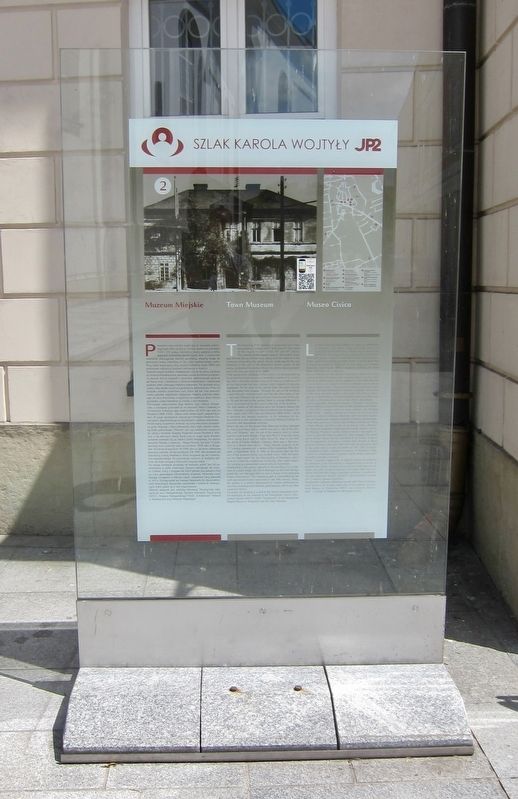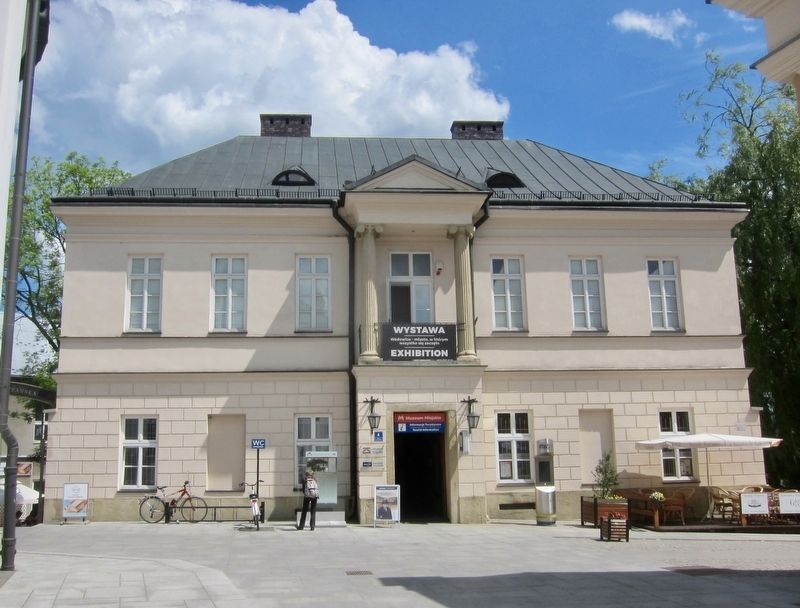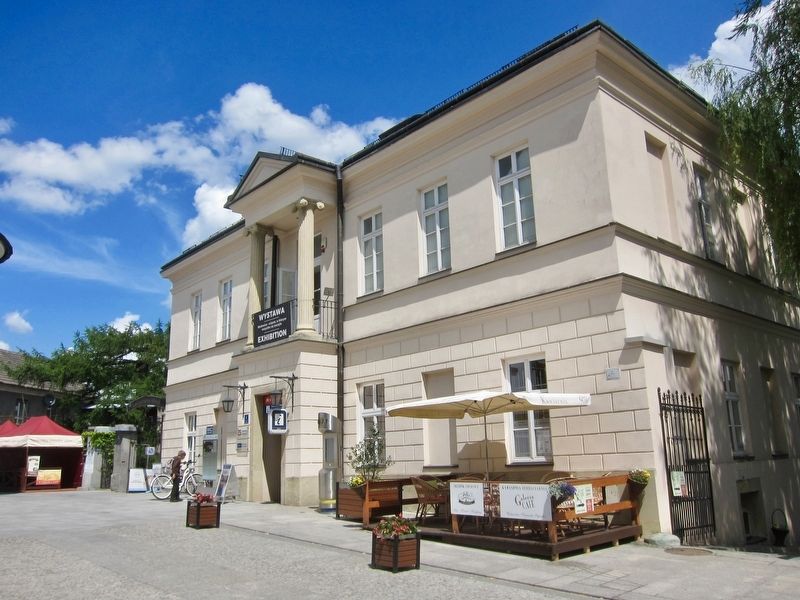Muzeum Miejskie / Town Museum / Museo Civico
Pope John Paul II (Karol Wojtyła) Foot Trail
The beginning of this building is associated with urban arrangement changes which took place in the centre of the city at the turn of the 18th and 19th century. The removal of the market square’s old eastern frontage, burned during several fires, along with the removal of the cemetery surrounding the parish church, made way for the new buildings in this part of the Wadowice market square. At the newly established Kościelna Street, the oldest masonry building in the city was built in ca. 1800.
From among other buildings at this street, it is distinguished by its architectural form, because it resembles a manor. It is a building with a centrally located front porch having a balcony with an iron balustrade and Ionic columns which support a triangular tympanum. At the level of the basement, the entire facility was decorated with bossage. Through the axis of the building, a pass-through vestibule leads and like the other rooms it has a sail vault. Between the main entrance from the side of Kościelna Street and the exit to the garden, there is a large difference in levels, as evidenced by the
stairs at the rear of the building.The first owners of this building were the Schwartz family and then it became a property of Maria Gedlowa nee Schwartz. Another owner, since 1919, was Jan Moskała (1868 – 1944) – doctor of medicine and popular physician. In his testament, he bequeathed it to the Jagiellonian University Medical College for scientific and educational activities.
Before the war, on the ground floor there was a dairy managed by Alojzy and Maria Banaś, which was also a seat of the football club “Polonia”. Jan, the son of the owners, went to school together with Karol Wojtyła, Pope John Paul II. It was this dairy where young Karol and his father Karol Sr. used to eat after the death of Emilia Wojtyłowa. Upstairs, there was a flat occupied by a Slovak from Levoča - Alojzy Machej, sergeant of the 12th infantry regiment and a soldier of the Carpathian Rifle Brigade in September 1939. In 1946, on the ground floor the first seat of the business school was located. Since 1968, the building has been owned by the Municipality of Wadowice, which received it from the Jagiellonian University. After major repairs, the building accommodated several cultural institutions.
Noteworthy is the garden adjacent to the building. It is a remnant of a much larger site which belonged to the Gedl family’s estate but over the
Currently, the building at 4 Kościelna Street is a seat of the Tourist Information Centre belonging to the network of the Małopolska Tourist Information System (MSIT), NSZZ "Solidariność" of the Małopolska Branch in Wadowice and the Town Museum.
-
Powstanie tego obiektu wiąże się ze zmianami urbanistycznymi jakie zaszły w centrum miasta na przełomie XVIII i XIX wieku. Likwidacja starej, spalonej w kilku pożarach wschodniej pierzei rynku wraz z usunięciem cmentarza otaczającego kościół parafialny, otwarły drogę do powstania nowej zabudowy w tej części wadowickiego rynku. Przy nowo wytyczonej ulicy zwanej Kościelną około 1800 roku wzniesiono najstarszy budynek murowany w mieście.
Spośród innych budowli znajdujących się na tej ulicy wyróżnia go forma architektoniczna, ponieważ swoim kształtem przypomina dworek. Jest to budynek z centralnie umieszczonym gankiem od
Pierwszymi właścicielami tego obiektu była rodzina Schwartzów, a następnie przeszedł on na własność Marii Gedlowej ze Schwartzów. Kolejnym jego właścicielem od 1919 roku był Jan Moskała (1868 – 1944) – doktor nauk medycznych i popularny lekarz. W swym testamencie zapisał go Collegium Medicum Uniwersytetu Jagiellońskiego na działalność naukowo – oświatową.
Przed wojną na parterze mieściła się tutaj mleczarnia prowadzona przez Alojzego i Marię Banasiów, która była również siedzibą klubu piłkarskiego „Polonia”. Jan, syn właścicieli, uczęszczał do szkoły z Karolem Wojtyłą, Papieżem Janem Pawłem II. Właśnie w tej mleczarni młody Karol wraz ze swym ojcem Karolem
Na uwagę zasługuje przyległy do budynku ogród. Jest on pozostałością o wiele większego obszaru należącego do majątku Gedlów, który z biegiem lat tracił jednak swą powierzchnię na rzecz powstającej infrastruktury miejskiej. Pozostałą część okalają, utrzymane w dobrym stanie, zabytkowe mury powstałe w XIX w. Dzisiaj ogród ten stanowi doskonałe tło dla przedstawień teatralnych, koncertów, warsztatów i widowisk tematycznych, które często są w nim organizowane.
Obecnie budynek przy ulicy Kościelnej 4 jest siedzibą Informacji Turystycznej należącej do sieci Małopolskiego Systemu Informacji Turystycznej (MSIT), Regionu Małopolskiego NSZZ "Solidariność"
-
La costruzione di questo edificio č legata ai cambiamenti urbanistici che ebbero luogo nel centro della cittŕ a cavallo tra il Settecento e l'Ottocento. La demolizione dell’antica, bruciata parte dei palazzi della parte orientalne della piazza, nonché il trasferimento del cimitero parrocchiale, apririono lo spazio per edifici nuovi in quella parte della Piazza principale di Wadowice. In una nuova via, chiamata Kościelna, verso l’anno 1800 fu innalzato l’edificio piů antico della cittŕ fabbricato in mattoni.
Esso si distingue da altri palazzi localizzati in quella via con la propria forma architettonica che assomilia ad un maniero nobiliare. Č un edificio con il portico situato al centro della facciata e con un balcone di balaustre di ferro e colonne ioniche con un timpano sopra di esse. In basso tutto il palazzo fu decorato con il bugnato. Sull’asse dell’edificio si trova un vestibolo con la volta a vela, come del resto anche in altre sale. Tra l’entrata principale in via Kościelna, e l’uscita al giardio esiste una differenza di livelli, confermata dalle scale situate dietro del palazzo.
I primi proprietari del palazzo furono i Schwartz, successivamente l’edificio si trovň nelle mani di Maria Gedlowa di Schwartz. Dal 1919 il palazzo ebbe un nuovo padrone, Jan Moskała (1868 – 1944) – medico e dottore di scienze che nel suo testamento lo donň al Collegium Medicum dell’Universitŕ Jagellonica di Cracovia per svolgere l’attivitŕ scentifica ed educativa.
Prima della guerra ci si trovava una trattoria condotta da Alojzy i Maria Banaś, nonché la sede di un club di calcio „Polonia”. Jan, figlio dei proprietari frequentava la scuola insieme con Karol Wojtyła. Proprio in quella trattoria Karol e suo padre venivano a pranzare dopo la morte di Emilia Wojtyła. Sul primo piano abitava Alojzy Machej, uno slovacco da Levoča, sergente del XXII reggimento di fanteria e soldato della Brigata di alpini polacchi durante la lotta del 1939. Nel 1946 sul pianoterra ebbe la sua prima sede la scuola di commercio. Dal 1968 l’Universitŕ Jagellonica donň il palazzo al Comune di Wadowice. Dopo i lavori di ristrutturazione il palazzo ospitň alcune istituizioni di profilo culturale e turistico.
Anche il giardino aggiacente al palazzo merita un momento di attenzione. Esso č il resto di un maggiore lotto di terreno di proprietŕ dei Gedel, che pian piano veniva ristretto per dare lo spazio alla cittŕ. La parte rimasta č circondata delle mura costruite nell'Ottocento. Oggi il giardino costituisce un palcoscenico per spettacoli teatrali, concerti e manifestazioni culturali che ci vengono spesso organizzati.
Attualmente il palazzo sulla strada Kościelna 4 costituisce la sede dell'Ufficio d'informazione turistica che fa parte della rete di Informazione turistica della Regione di Małopolska (MSIT), del sindicato "Solidariność" - la filiale di Wadowice e del Museo Civico.
Erected 2005 by Tourist Information System of Małopolska. (Marker Number 2.)
Topics. This historical marker is listed in these topic lists: Architecture • Churches & Religion. A significant historical month for this entry is September 1939.
Location. 49° 53.006′ N, 19° 29.646′ E. Marker is in Wadowice, Małopolska (Lesser Poland), in Wadowice Powiat. Marker is at the intersection of Kościelna and plac Jana Pawła II, on the right when traveling north on Kościelna. Touch for map. Marker is at or near this postal address: Kościelna 4, Wadowice, Małopolska 34-100, Poland. Touch for directions.
Other nearby markers. At least 5 other markers are within 14 kilometers of this marker, measured as the crow flies. Wadowice Tobruk and Monte Cassino World War II Memorial (within shouting distance of this marker); Wadowice 12th Infantry Regiment War Memorial (within shouting distance of this marker); Świętemu Janowi Pawłowi II / His Holiness Pope John Paul II (within shouting distance of this marker); Pope John Paul II's Former School (within shouting distance of this marker); Bazylika / Basilica (approx. 13 kilometers away).
More about this marker. Although not quite visible from John Paul II Square, the marker and museum are easily found. When in the square and facing both the church and the Pope's former boyhood home (to the right of the church when facing it), simply walk between the two to the rear of both buildings, as the museum is right there. Alternatively, one could walk around either building and then hook back around.
Also see . . . Karol Wojtyła Foot Trail (Tourist Information System of Małopolska). (Submitted on June 21, 2018.)
Credits. This page was last revised on June 21, 2018. It was originally submitted on June 21, 2018, by Andrew Ruppenstein of Lamorinda, California. This page has been viewed 152 times since then and 8 times this year. Photos: 1, 2, 3, 4. submitted on June 21, 2018, by Andrew Ruppenstein of Lamorinda, California.



